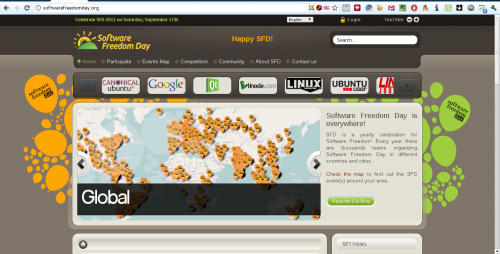Flickr blog post yesterday celebrated 200,000,000 images published under Creative Commons license. According to the same blog post, this makes Flickr the largest Creative Commons image repository in the world. This is indeed a huge and important milestone and I congratulate Flickr and everyone involved in achieving it. I’ve always said that there are many photo sharing websites that serve different audiences, tastes, and preferences. But Flickr goes beyond that by providing an excellent Creative Commons platform. I hope that this will grow and flourish.
Tag: Open Source
Happy Software Freedom Day!
Apparently, today is the Software Freedom Day. If you are asking yourself the question: “What is Software Freedom Day?”, the official website has an answer for you.
Software Freedom Day is a worldwide celebration of Free and Open Source Software (FOSS). Our goal in this celebration is to educate the worldwide public about the benefits of using high quality FOSS in education, in government, at home, and in business — in short, everywhere!
Being a great fan of, user, and contributor to Free and Open Source Software I think that this is an excellent idea. I also understand the benefits of always having it on a weekend day, so that meetings could be organized easier. But I have to say that I am not a big fan of using moving dates for holidays. It makes it difficult to remember and prepare to. Just have a look at how popular Sysadmin Day is and that one is celebrated for years now.
Either way, happy Software Freedom Day! If you are a contributor to Free and Open Source Software, I thank you and hope you will get more appreciation for the work you do. If you are just a user, I hope you will find a way to contribute soon, even if that is just buying a beer to a contributor next to you. And if you are a poor soul who haven’t heard about Free and Open Source Software, please educate yourself – you are missing out. You can start with Wikipedia pages for Free Software and Open Source Software. If you need any help, feel free to contact me or anyone else who is already a member of the cult. One thing is for sure though. It doesn’t matter if you believe in Free and Open Source Software or not, if you are reading this – you’ve definitely used and benefited from it. No? Yes you did. You are on the Internet, aren’t you…
Pantone Inc and Open Source
I came across an interesting paragraph in Wikipedia page on Pantone Inc.
Pantone asserts that their lists of color numbers and pigment values are the intellectual property of Pantone and free use of the list is not allowed. This is frequently held as a reason why Pantone colors cannot be supported in Open Source software such as GNU Image Manipulation Program (GIMP) and are not often found in low-cost software.
One more thing
Last year Matt Mullenweg wrote this post and I somehow missed it.
There is a dark time in WordPress development history, a lost year. Version 2.0 was released on December 31st, 2005, and version 2.1 came out on January 22nd, 2007. Now just from the dates, you might imagine that perhaps we had some sort of rift in the open source community, that all the volunteers left or that perhaps WordPress just slowed down. In fact it was just the opposite, 2006 was a breakthrough year for WP in many ways: WP was downloaded 1.5 million times that year, and we were starting to get some high-profile blogs switching over. The growing prominence had attracted scores of new developers to the project and we were committing new functionality and fixes faster than we ever had before.
What killed us was “one more thing.” We could have easily done three major releases that year if we had drawn a line in the sand, said “finished,” and shipped the darn thing. The problem is that the longer it’s been since your last release the more pressure and anticipation there is, so you’re more likely to try to slip in just one more thing or a fix that will make a feature really shine. For some projects, this literally goes on forever.
On Linux and Android relationship
Linux Weekly News did an excellent coverage of James Bottomley talk at LinuxCon Japan on Linux and Android relationship. I’ve read several opinions on the matter and this one seems to be the most balanced and objective. There is something to learn here for every open source developer and enthusiast.
The community should do better at fostering and embracing diversity, encouraging forks (which can create significant progress) and helping them to merge back. Currently, James said, the kernel gets a “C – must do better” grade at best here. We only take code from people who look like us; as a result, the Android merge attempt was more painful than it needed to be.
Companies, in turn, should aim for “control by acclamation” rather than control by total ownership. Linus Torvalds was given as an example; he has a lot of control, but only because the community trusts him to do the right thing. In general, if the community trusts you, it will happily hand over a lot of control; that’s why the benevolent dictator model is as common as it is. On the other hand, companies which try to assert control through walled garden development or by demanding copyright assignment from contributors have a much harder time with the community.
In summary, James said, Android was a fiasco for everybody involved; we all need to figure out how to do better. We need to find better ways of encouraging and managing forks and allaying licensing fears. Projects which create forks should be thinking about merging back from the outset. Then projects which (like Android) are a commercial success can also be a community success.

